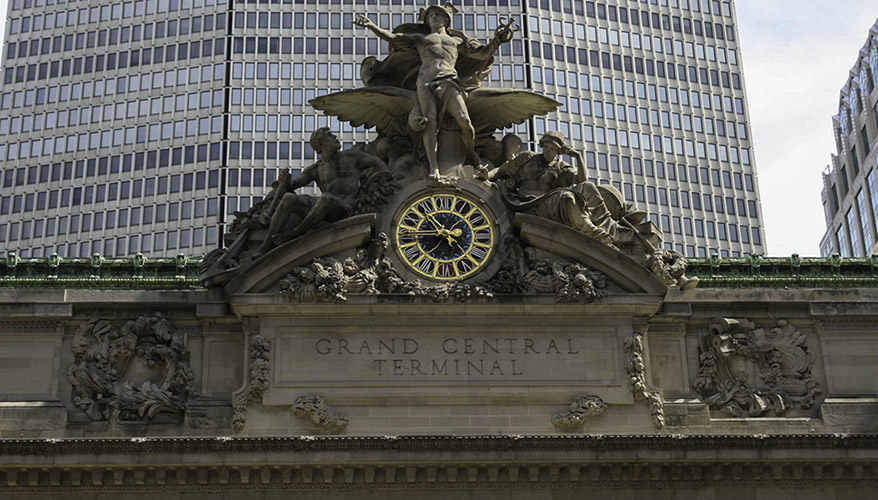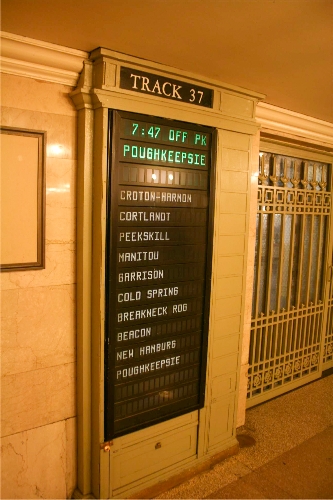

Grand Central Terminalis a historic Beaux-Arts train terminal (a terminal because all trains end at it, no trains run through it) opened in 1913 and was fully renovated, restored, and rededicated in 1998. It is an iconic railroad station and one of the most visited places in the world. People visiting the station include both tourists going to look at the iconic main concourse, dine and shop, plus commuters going to catch trains (the last intercity train left with Amtrak in 1991) since it is still the second busiest train station in the United States, after New York Penn Station, just across town. The terminal was completely redeveloped in the 1990s and today contains a variety of shops and restaurants, the funds from these tenants, used to help the MTA fund the restoration of the station. The station was nearly torn down (after the even grander Pennsylvania Station across town was in the 1960s) to develop large office buildings in the air rights above it, and the 1978 Supreme Court Case Penn Central vs. NYC upheld the legality of landmark preservation laws in the United States and required the station to be preserved.
The station is located directly in the middle of Park Avenue, with motor traffic on Park Avenue re-routed on the Park Avenue viaduct that surrounds the upper levels of the terminal and is elevated from existing streets. The Park Avenue viaduct surrounds (the roadway is split in each direction) the main terminal, the MetLife Building (former PanAm Building), just north of the station, and goes through the Helmsley Building (formerly the New York Central Building). The terminal is located at the Northwest Corner of Vanderbilt Avenue and 42nd Street, with three corridors extending from the terminal, seamlessly beneath and through the first level of other office buildings to Lexington Avenue. The station and it’s terminal city complex (including the Metlife Building) cut 43rd and 44th Streets into two, making them not through streets. There is also an entrance into the terminal through a passageway from 45th Street.
The best place to start a tour of Grand Central is from the main entrance along 42nd Street beneath the Park Avenue viaduct across from Pershing Square. Here passengers enter to a wide corridor that is actually a gradual sloping ramp, first reaching Vanderbilt Hall, the former main waiting room that was renovated into a special event space, with the Great Northern Food Hall permanently built into the western half of the space in 2016. From here the passageway continues across a bridge over the ramps to the lower level past the backs of the ticket offices and into the station’s Main Concourse.
The station’s main concourse is home to the iconic mural of the heavens showing the constellations in reverse, as if God is looking down on the station concourse. Gates lead out from the north side to the former long distance departure platforms opposite two large banks of ticket windows, one formerly serving the tenant New Haven Railroad, and the other formerly for the New York Central Railroad, these ticket offices are beneath large color LCD screen departure boards that were installed in 2019 and have three different sections for the New Haven Line, two for the Harlem Line and one for the Hudson Line (this is based on the fact the New Haven Line has so many more trains than the Hudson Line). Originally chalk boards were handwritten for departing trains. Flip boards were installed in their current location from 1967 until 1996, when LED departure boards were installed, replaced with the current (and controversial) modern color LCD screens in 2019.
In the Main Concourse grand staircases, the western one historic to the station, the eastern one installed in the 1998 renovation based on original blueprints for it, lead up to mezzanines. The western one leads past three fine dinging restaurants and out to the station’s, now closed to all vehicles, taxi drop-off/pick-up loop beneath the Park Avenue Viaduct along Vanderbilt Avenue at the end of 43rd Street. The eastern one is the entrance to the Apple Store that opened in 2012; and allows the public to access some historic rooms that were formerly a fine-dining restaurant after the 1996 renovation. Escalators lead up from the center of the great hall to the Metlife Building and 45th Street through its lower level.
In the center of the Main Concourse is the information booth with the iconic four-sided clock. This information booth is directly above the lower-level concourse, with a spiral employee-only staircase leading from the upper-level information booth to the now normally closed lower-level information booth. This lower-level concourse was known as the Suburban Concourse with its 100 series tracks designed for use by regional trains. Today it is home to the Dining Concourse with various food stalls and tables. It is primarily accessed via a grand ramp from the middle of the low-level concourse, this leads up to an area beneath the bridge used by the main entrance with a Guastavino Tiled ceiling, and the entrance to the Grand Central Oyster Bar and Grill. The Oyster bar has existed since the station opened (formerly the Grand Central Restaurant) and has a similarly tiled roof throughout it’s main dining room. Beneath this historic ceiling two additional ramps lead up to side passages that connect to each side of the main concourse. The western leads to the Shuttle Passage that leads to the main entrance to the 42nd Street Shuttle, and a steeper ramp up to doors out to 42nd Street. The eastern one is the 42nd Street Passage that leads to the main entrance (with escalators and an elevator) down to the 4/5/6/7 trains and doors out to 42nd Street. There are also staircases down to it, between the staircases up to the mezzanines, plus escalators up from each end of the dining concourse up to the main level beneath each balcony staircase.
There are 3 additional passages that run from the Main Concourse to Lexington Avenue, all leading to doors out to Lexington Avenue. The most northern one is the Graybar Passage that provides gate access to Tracks 11 through 16, and out to Lexington Avenue and various shops. The middle one is the Grand Central Market that contains stalls selling various fine foods, it has doors at its entrances that are locked when the Market is closed. The southern-most passage is the Lexington Passage, this includes an entrance to the Grand Hyatt Passage up to the Grand Hyatt Hotel at the corner of Lexington Avenue and 42 Street, and another entrance to the northern fare control area (with just staircase access) of the 4/5/6/7 subway train’s mezzanine, plus additional retail.
Leading from the western end of the Great Hall, passengers first reach the Station Master’s Office, this area includes the remaining small waiting room (with historic wooden benches) for passengers awaiting trains. Nearby is an annex of the Transit Museum with a small gallery and store, and the Biltmore Room. The Biltmore Room is the former long-distance trains arrival area and the area still contains a chalkboard that still displays some historic arriving trains. It is one of the most-quiet areas of the station. A staircase leads up to 43rd Street, and the 45th Street passageway leads north to an entrance from 45th Street.
Photos 1-2: June 2, 2009; 3-4: June 12, 2010; 5-7: August 12, 2011; 8-21: August 13, 2011; 22-29: August 29, 2011; 30-34: September 14, 2011; 35-46: December 6, 2011; 47-76 October 31, 2012; 77-80: November 1, 2012; 81-83: November 2, 2012; 84-101: February 1, 2013; 102: May 10, 2013; 103: May 12, 2013; 104: June 30, 2014; 105-133: July 17, 2015; 134-135: January 30, 2013; 136-143: March 8, 2013; 144 & 145: March 12, 2013; 146 & 147: March 31, 2013; 148-154: May 24, 2013; 155-169: July 20, 2013; 170-177: December 3, 2013; 178-200: September 3, 2023;
Arts For Transit at Grand Central
